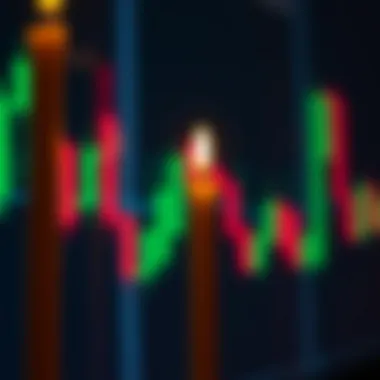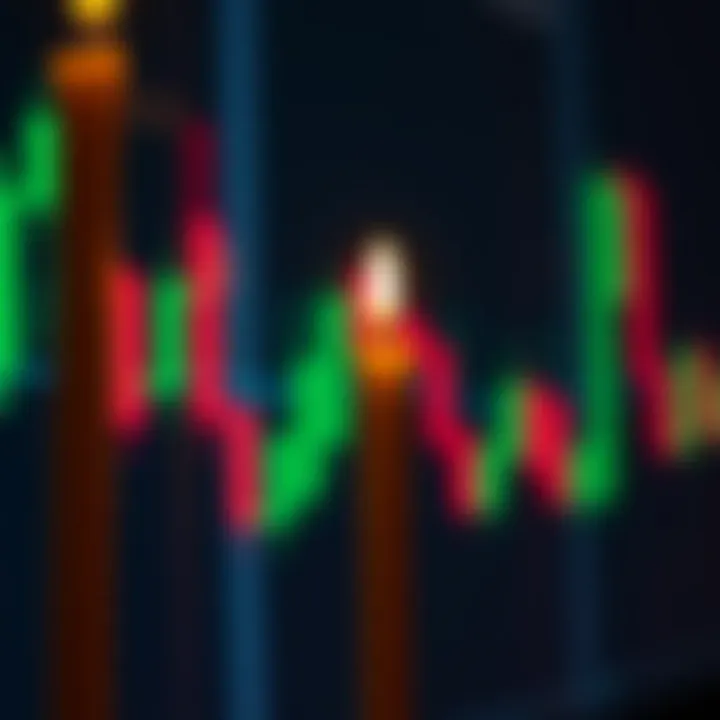Decoding Single Candlesticks in Crypto Trading


Intro
The cryptocurrency market operates in a dynamic environment characterized by high volatility and rapid changes. In this context, single candlesticks emerge as significant indicators for traders assessing market behavior. Each candlestick represents a specific time frame, encapsulating four vital data points: open, high, low, and close prices. Understanding these elements can guide traders in making informed decisions, whether they are just starting out or have been navigating the crypto waves for years.
Key Concepts in Cryptocurrency
Definition and Importance
To grasp the essence of single candlesticks, it’s essential to first consider what cryptocurrency trading entails. At its core, cryptocurrency is a digital or virtual currency that relies on cryptography for its security. This innovative form of currency operates on decentralized platforms, primarily driven by blockchain technology. The importance lies not only in the financial implications but also in the disruptive technology that underpins the entire ecosystem. Understanding these foundational concepts helps traders read candlestick patterns effectively, tying the visual representation of price action back to the market’s underlying sentiment.
Blockchain Technology Overview
Blockchain technology acts as the backbone of cryptocurrency. It is essentially a distributed ledger that records all transactions across a network. Each block in the chain contains several transactions, linked through cryptographic hashes. This decentralization not only enhances security but also increases transparency.
By understanding this technology, traders can better interpret the reasons behind price movements. Market shifts often align with significant events or developments in the blockchain space. Monitoring these trends can aid in predicting market reactions, thus enhancing the utilization of candlestick analysis.
"Understanding the underlying technology of cryptocurrencies opens a broader perspective to market movements and trends."
Trends and Innovations
Emerging Cryptocurrencies
As the crypto space evolves, a wave of new cryptocurrencies emerges regularly, each bringing unique features or innovations. Tokens like Solana and Polkadot have garnered attention for their scalability and interoperability, while others, like Shiba Inu, leverage community engagement to drive value. The proliferation of these assets contributes to a more diverse trading landscape. Traders must stay vigilant about new entries and their potential impacts on existing market dynamics, as new cryptocurrencies can lead to sudden spikes or drops that are often reflected in candlestick patterns.
Technological Advancements in Crypto
Technological advancements continue to reshape the cryptocurrency landscape. Innovations in areas like DeFi (Decentralized Finance), DAOs (Decentralized Autonomous Organizations), and NFTs (Non-Fungible Tokens) not only attract more investors but also influence trading behavior. Tools like decentralized exchanges (DEXs) and automated trading systems utilize candlestick patterns to execute trades more efficiently, offering insights that traditional methods might overlook.
Keeping abreast of such advancements will allow traders to decode market indicators like candlesticks with greater precision, integrating modern tools to gain a competitive edge. Crucially, those engaged in the cryptocurrency trading realm must adapt continuously to these changes, understanding how single candlesticks reflect broader market trends while also aligning their strategies accordingly.
Prelude to Candlestick Charts
In the evolving landscape of cryptocurrency trading, understanding the tools at your disposal is key to making informed decisions. One of the most insightful tools is the candlestick chart. These charts not only depict price movements but also convey the emotions and behaviors of traders over given time frames. For seasoned investors and newcomers alike, mastering candlestick charts can significantly sharpen one’s trading skills.
Historical Context of Candlestick Charts
Candlestick charts have their origins in Japan, dating back to the 18th century when rice traders sought a better way to track price movements. This innovative method allowed them to visualize market trends more effectively than traditional line charts. The rich history of candlestick charts underscores their enduring effectiveness and intricacies, moving from rice grain trading to today's bustling cryptocurrency markets.
Understanding this historical grounding establishes a sense of respect for the candlestick's utility in modern trading strategies. It highlights how these charts have evolved while retaining their core benefits: clarity, precision, and emotional insight into market behavior.
Fundamentals of Candlestick Construction
At a glance, a single candlestick may appear simple. However, each one is a complex representation of market activity. Every candlestick comprises four crucial components: the opening price, the closing price, the highest price, and the lowest price during a specified time period.
- Open: The price at which a trading period begins.
- Close: The price at which a trading period ends.
- High: The highest price reached during the period.
- Low: The lowest price recorded in the same timeframe.
The body of the candlestick indicates whether the price increased or decreased during that period, while the wicks (or shadows) show the extreme prices reached. Recognizing how these elements come together helps traders gauge market sentiment effectively.
Why Candlestick Charts Matter in Trading
The significance of candlestick charts in trading is profound. They allow for a more visual approach to market analysis, where traders can discern patterns and trends with relative ease. Candlestick patterns can signal potential price reversals or continuations, providing vital clues about future market behavior.
Using candlestick charts, traders can:
- Identify trends quickly. Recognizing upward or downward momentum is essential.
- Spot reversals. Certain patterns hint at possible shifts in market sentiment.
- Enhance decision-making. Combining these visual cues with other indicators fosters a more robust trading strategy.
In summary, mastering candlestick charts equips traders to make judicious decisions, enhancing one’s ability to navigate the volatile cryptocurrency landscape with confidence.
Understanding candlestick charts is not just an academic exercise; it's a vital skill that empowers traders to interpret market moods and movements effectively.
Breakdown of a Single Candlestick
To truly grasp the nuances of cryptocurrency trading, one must delve into the breakdown of a single candlestick. This foundational element of candlestick analysis serves not just as a visual representation of price movements but encapsulates a wealth of information about market sentiment and trading behavior. Understanding these components is vital for traders aiming to make informed decisions.
Defining the Open, Close, High, and Low
When discussing a single candlestick, four key prices are at its core: the open, close, high, and low. The open refers to the price at which a particular time period begins. For example, in a daily candlestick, this is the price when the market opens each day. Conversely, the close marks the last price at which the asset is traded within that timeframe. This is often viewed as an important price point, as it reflects the consensus value at the end of the trading period.
- High is the peak price reached during that timeframe. It shows the maximum willingness of buyers to pay.
- Low indicates the lowest price during the period, representing the minimum that sellers were willing to accept.


Together, these elements create a framework for analyzing market dynamics and can signal potential bullish or bearish trends depending on their relationship with one another. If the close is higher than the open, it typically indicates bullish sentiment. Conversely, a close below the open can signify bearish pressure.
The Body and Shadows of Candlesticks
Next, let's break down the visual components of the candlestick itself. The body of the candlestick signifies the range between the open and close prices, while the shadows (sometimes called wicks) extend from the body to illustrate the high and low prices.
- A long body suggests strong price movement in the direction of the close, while a small body indicates relative indecision.
- Longer shadows can indicate volatility, showcasing that prices swung significantly within the timeframe but settled closer to the opening or closing prices.
For instance, a candlestick with a small body and long shadows on both sides might signify market indecision, hinting that neither buyers nor sellers have gained the upper hand. Understanding these visual cues can provide insights into potential market reversals or continuations.
Color Significance in Candlesticks
The color of a candlestick can also provide valuable insights into market behavior. Most commonly, a green (or white) candlestick indicates that the closing price was higher than the opening price, showcasing bullish market sentiment. In contrast, a red (or black) candlestick signifies that the closing price fell below the opening price, indicating a bearish sentiment.
However, it's crucial not to view color in isolation. The context in which a candlestick appears can greatly affect its interpretation. For instance:
- A long green candlestick following a series of red ones could indicate the start of a bullish trend.
- Meanwhile, a red candlestick at the top of an upward trend may suggest a potential reversal or profit-taking event.
"Context is everything in candlestick analysis. A single candlestick may tell one story, but its placement within the broader trend narrates the full picture."
In summary, the breakdown of a single candlestick is a fundamental step in mastering candlestick analysis. By intimately understanding the open, close, high, low, the body, shadows, and color significance, traders equip themselves with vital tools necessary for making informed and strategic trading decisions in the volatile world of cryptocurrency.
Interpreting Single Candlesticks
Interpreting single candlesticks holds a key position in the landscape of cryptocurrency trading. These candlesticks serve as foundational elements, abstracting emotional market reactions into visual representations that traders can easily digest. By grasping the implications of individual candlesticks, one can make more informed trading decisions, deciphering market sentiment with astonishing clarity.
Bullish and Bearish Indicators
Bullish and bearish indicators are archetypal signs in the trading world, where candlesticks play an instrumental role. A bullish candlestick signals an upward trend. A green (or hollow) body shows that the closing price is higher than the opening price. This suggests buying momentum, often giving traders a readable impulse to enter a long position. Conversely, when the structure is red (or filled), it typically indicates a bearish candlestick, suggesting potential price declines and prompting a strategy for selling or shorting.
- Key Takeaways:
- Bullish: Open lower, close higher.
- Bearish: Open higher, close lower.
Bullish patterns such as the hammer signify the rejection of lower prices and displayed strength. For instance, a hallowed hammer after a downtrend hints that buyers are stepping in. On the other hand, bearish indicators provide caution; the shooting star pattern suggests potential reversals, especially when observed at a market peak.
"Interpreting these indicators allows traders to harness market psychology, making decisions that rely on more than just technical numbers."
Doji Candlestick Analysis
The doji candlestick is an intriguing formation, and its analysis is fundamental for traders seeking insight into potential market reversals. A doji appears when the opening and closing prices are virtually identical, creating a squashed appearance. This formation reflects market indecision and can signal a turning point when following a strong trend.
- Types of Doji:
- Standard Doji: Showcases indecision.
- Gravestone Doji: Potential bearish reversal signal, often after an uptrend.
- Dragonfly Doji: Indicates a possible bullish reversal after a downtrend.
Given their uniqueness, dojis can be impactful. Traders often look for confirmation with subsequent candlesticks. If a doji occurs at a resistance level and is followed by a bearish confirmation, it might suggest that the market is losing upward momentum, inviting caution. On the flip side, a doji after a downtrend followed by a bullish close draws traders towards possible rebounds.
Spinning Tops and Bottoms
Spinning tops and bottoms offer valuable insights into trader sentiment and potential reversals. A spinning top has a small body with long wicks on both sides, similar to dojis, suggesting uncertainty but with a bit more action in price movement. This formation typically arises in trending markets and could hint at weak continuation of the current trend.
- Characteristics:
- Spinning Top: Indicates indecision.
- Spinning Bottom: Appears at market declines; suggests potential upward reversal.
When a spinning bottom forms at the end of a downtrend, it can signify a fight between buyers and sellers. After this formation, the subsequent price action often sheds light on the market's direction. A strong bullish candle emerging after a spinning bottom could essentially confirm buy signals.
In summary, the interpretations of single candlesticks extend beyond mere analysis; they encapsulate the psychology of market participants. By recognizing what these formations signify within their respective contexts, traders can fully leverage candlestick analysis in their trading strategies.
Common Candlestick Patterns
In the realm of cryptocurrency trading, understanding common candlestick patterns can offer significant advantages for traders. These patterns serve as visual indicators that help in predicting future price movements based on past behavior. Recognizing patterns can guide traders in making informed decisions, potentially leading to profitable trades.
Hammer and Hanging Man Patterns
The hammer and hanging man candlestick patterns, while distinct, often confuse traders. A hammer forms after a downtrend and suggests a potential reversal. Its structure includes a small body at the top and a long lower shadow, which indicates that buyers attempted to push prices higher. In contrast, the hanging man appears after an uptrend and signals a possible reversal to the downside. It also has a small body at the top and a long lower shadow, but its presence following an upward trend suggests that selling pressure may be taking hold.
When traders see a hammer, they might consider it a sign to buy, as it indicates bullish momentum. Conversely, if a hanging man pops up, it can be a cue to sell or hold off on purchasing, as it often precedes a market dip.


Here’s a quick recap of the key elements:
- Hammer: Signals potential bullish reversal. Appears after declines.
- Hanging Man: Indicates possible bearish reversal. Follows an uptrend.
"Understanding these patterns can make the difference between riding the wave and getting swept under it."
Engulfing Patterns
Engulfing patterns come in two forms: bullish and bearish. A bullish engulfing pattern appears when a small bearish candle is followed by a larger bullish candle that completely engulfs it. This scenario reflects a change in momentum, where buyers have overpowered sellers, indicating a potential upward trend.
On the flip side, a bearish engulfing pattern signals a trend reversal after an uptrend. It occurs when a small bullish candle is succeeded by a larger bearish candle that engulfs the former. This pattern suggests that sellers are gaining control, potentially foreshadowing a decline in prices. For traders, spotting these patterns can be vital, as they often signify stronger moves in the market.
Shooting Star Analysis
Shooting stars are another crucial pattern to understand. This pattern appears at the top of an uptrend and signals a potential bearish reversal. The structure resembles that of a hammer but is characterized by a small body at the bottom and a long upper shadow. It illustrates that buyers pushed prices higher, but sellers stepped in, driving prices back down.
The shooting star indicates that a trend may be losing strength. Traders often take note of this pattern as a cue to consider exiting their long positions or possibly entering short ones. Recognizing this can prevent unnecessary losses.
To sum it up, spotting common candlestick patterns requires close observation and practice. Here are a few points to keep in mind:
- Each pattern tells a story of market sentiment.
- Context matters: observe the patterns in relation to the trend.
- Utilize other indicators for confirmation to enhance decision-making.
By learning these common patterns, traders enhance their arsenal, boosting their chances of identifying profitable opportunities in the crypto market.
Implementing Candlestick Analysis in Trading Strategies
In the domain of cryptocurrency trading, implementing candlestick analysis transcends mere observation of price movements; it’s a strategic tool that sharpens decision-making. This section unpacks the importance of this methodology, emphasizing its role in enhancing overall trading efficacy. Through effective integration of candlestick analysis, traders can develop a clearer understanding of market dynamics, leading to informed decisions.
Combining Candlesticks with Other Indicators
Using candlestick patterns alongside other indicators can be likened to multi-layering an outfit for weather prediction — one layer alone might not suffice. A singular candlestick may tell a story, but when combined with indicators like moving averages, Relative Strength Index (RSI), or MACD, the narrative becomes richer and more assertive. For instance, when a bullish engulfing pattern appears alongside an upward crossover in the moving average, it's a potent signal.
- Moving Averages: These help in smoothing out price action and can confirm trends, providing additional context to candlestick signals.
- RSI: This momentum indicator can provide insights on overbought or oversold conditions, thus offering clarity to how a candlestick should be interpreted.
- MACD: When used together with candlestick patterns, MACD can enhance the confirmation process for potential trend reversals.
This synergistic approach ideally lowers the likelihood of false signals, allowing traders to navigate the volatile waters of cryptocurrency markets with greater confidence.
Risk Management Techniques
Risk management forms the bedrock of any trading strategy, and integrating candlestick analysis is essential in this regard. Recognizing the limitations of individual candlesticks, it’s vital to establish sound risk management techniques. Here are some practical considerations:
- Set Stop-loss Orders: After identifying a candlestick pattern signaling a trade, position stop-loss orders just beyond the nearest support or resistance level.
- Position Sizing: Determining how much of a particular cryptocurrency to trade based on candlestick signals can safeguard against potential losses. A trader might decide to risk only a small percentage of their total capital on a single trade, adjusting the size based on the volatility indicated by candlesticks.
- Diversification: Relying solely on one type of analysis or a unique asset can be precarious. Diversifying the portfolio can minimize the risk while capitalizing on different candlestick patterns across various cryptocurrency assets.
Engaging with these techniques can mean the difference between sleepless nights over errant trades or calmly riding the market waves.
Developing a Trading Plan with Candlestick Insights
Crafting a well-structured trading plan that incorporates candlestick insights is cornerstonal. A trader’s plan should detail Entry, Exit, and Adjustment strategies founded on candlestick analysis, providing a roadmap that replaces haphazard decision-making with deliberate action.
- Define Entry Points: Look for specific candlestick patterns signaling potential entry points. For instance, a hammer followed by a strong bullish candlestick can serve as an excellent entry trigger.
- Establish Exit Strategies: Identify limitations by delineating when to walk away from a trade profitably. This might involve recognizing when a bearish reversal pattern forms or taking profits once predetermined levels are reached.
- Review and Refine: Each trade executed should be a learning opportunity. Maintaining a trading journal to record what candlestick patterns were observed and the resulting outcomes will cultivate a continuous learning process, sharpening future strategies.
Software and Tools for Candlestick Analysis
Navigating the cryptocurrency market requires not just wisdom in trading but also the right tools to make it easier to interpret data. Software and tools for candlestick analysis play a pivotal role in this aspect. Good tools can transform complex market data into visuals that make understanding nuances clear and actionable. Not only do they help in observing past market behaviors, but they also assist in predicting potential future movements. Here, we'll delve deeper into the various aspects of software and tools that optimize candlestick analysis.
Popular Trading Platforms
In the world of cryptocurrency trading, several platforms stand out due to their robust functionality and user-friendly interfaces. Whether you’re a newcomer or a seasoned veteran, these platforms make analysis easier:
- Binance: Known for its extensive range of cryptocurrencies, Binance offers advanced charting tools that let traders view candlesticks across various time frames, from minutes to months.
- Coinbase Pro: The professional version of Coinbase provides charts that display candlestick patterns and also integrates with external tools for more detailed technical analysis.
- Kraken: This platform combines a user-friendly interface with powerful analytical tools tailored for serious traders. The charting features enhance the experience of scrutinizing candlestick formations.
These platforms not only display prices and trading volumes, but also allow for intricate candlestick analysis which can be vital for making informed decisions in an ever-fluctuating market.
Charting Software Features
An ideal charting software should streamline the trading process through various features that enhance candlestick analysis. Here are some key attributes that are commonly found in such software:
- Customizable Time Frames: The ability to adjust the time frame of candlesticks allows traders to zoom in on specific periods of trading activity.
- Multiple Overlay Indicators: Good software often allows users to apply various indicators such as moving averages, Bollinger Bands, or Relative Strength Index alongside candlestick charts for deeper insights.
- Trade Simulation Tools: Some trading platforms feature simulators that allow traders to practice their strategies without risking real capital. This can help in understanding how candlestick patterns might play out in hypothetical scenarios.
- User Alerts: By setting alerts based on candlestick patterns, traders can be notified of significant market events as they happen.
- Integrated News Feed: Having access to relevant news right alongside candlestick charts can help traders correlate market movements with external factors.
Incorporating these features into your trading strategy can drastically improve the accuracy of analyses and subsequent trading decisions.


Free vs. Paid Tools: An Overview
When it comes to charting tools, the decision to use free or paid options often depends on your trading goals and experience level. Here's a brief comparison between the two:
- Free Tools:
- Paid Tools:
- Often very accessible and a good starting point for newcomers.
- Basic features sufficient for casual trading.
- Examples include TradingView's free version and CoinMarketCap's charting.
- Typically offer advanced features and functionalities.
- Enhanced capabilities such as complex indicators, historical data analysis, and greater customization options.
- Platforms like MetaTrader include subscriptions that provide extensive analytical distributions.
Utilizing a combination of free and paid tools can give traders better insights, allowing them to evolve as they gain more experience in the realm of cryptocurrency trading.
In the world of cryptocurrency trading, it’s often said: "The right tools can be the difference between a hobby and a successful career." This rings true especially when it comes to mastering candlestick patterns.
For more resources, consider checking out TradingView or CoinMarketCap for charting software insights and comparisons. Understanding these tools can vastly improve your ability to make decisive actions in the dynamic crypto market.
Candlestick Analysis Misconceptions
When navigating the often-volatile waters of cryptocurrency trading, traders wield candlestick charts as valuable tools. However, their interpretations can lead to misunderstandings and miscalculations. Addressing misconceptions around candlestick analysis is crucial in this article because it helps to foster a more accurate and confident trading approach.
Common Misinterpretations of Candlestick Patterns
One prevalent misconception is the overemphasis on single candlestick patterns to predict market directions. Many traders believe that spotting a specific candlestick shape, such as a hammer or doji, guarantees a market move. In reality, these patterns often serve as hints rather than definitive signals. For instance, a bullish engulfing pattern might appear, yet if market sentiment swings from overall bearish conditions, that signal could be misleading.
Moreover, traders might wrongly interpret the color of the candlestick body. A common belief is that a green (or white) candle automatically signifies a bullish trend, while a red (or black) candle suggests bearishness. This interpretation neglects the broader context, such as volume and market news, that influences price movement. Ignoring these additional factors can be akin to reading only the first chapter of a thrilling novel, leaving crucial plot twists unexamined.
Limitations of Candlestick Analysis
While candlestick charts provide valuable insights, they're not infallible. One significant limitation is their reliance on past price actions to predict future movements. Such historical data, while useful, cannot always anticipate unprecedented events in the crypto space. Regulatory changes, sudden market news, or hacker attacks can cause movements that candlestick analysis simply cannot foresee.
Another limitation comes from the subjective nature of interpreting candlestick patterns. For example, two traders could analyze the same chart and derive conflicting insights based on their personal experiences or biases. This variability can lead to indecision and inconsistency in trading strategies, often proving counterproductive.
The Importance of Context in Candlestick Analysis
Understanding the context in which a candlestick pattern appears is vital for accurate analysis. Candlesticks don’t operate in a vacuum; their meaning shifts dramatically based on surrounding price action, market sentiment, and external factors. For instance, a doji in an uptrend can signal indecision, suggesting a potential reversal; however, in a downtrend, it might merely denote a pause before the price continues to drop.
Additionally, analyzing candlestick formations in combination with other technical indicators, such as volume and moving averages, can provide a more robust view of market dynamics. Just like a piece of art, where the viewers' interpretations may vary based on surrounding influences, traders must consider the broader market context when analyzing candlesticks.
"The right context enriches the analysis, guiding traders through ambiguity towards informed decision-making."
To sum up, identifying misconceptions surrounding candlestick analysis is essential in shaping effective trading strategies. By recognizing that candlestick patterns should be viewed with care and context, traders can enhance their decision-making and improve their engagement with the cryptocurrency markets.
The Future of Candlestick Analysis in Cryptocurrency
The landscape of cryptocurrency trading is constantly shifting, making it crucial for traders to adapt their strategies and tools. Among these tools, candlestick analysis has proven to be highly valuable. Understanding how this analysis will evolve is essential for anyone looking to stay ahead in the fast-paced crypto market. The future of candlestick analysis in cryptocurrency is likely to be influenced by several trends and advancements, offering not only insights into market movements but also potential ways to optimize trading strategies.
Emerging Trends in Trading Techniques
New technologies and methodologies are emergent, reshaping how traders utilize candlestick charts. One major trend is the integration of machine learning algorithms, which can analyze vast amounts of data faster than any human. These algorithms are able to identify patterns in price movements that may take an average trader a long time to spot. The result? A more precise and quicker decision-making process.
Furthermore, algorithmic trading techniques, where traders use sophisticated software to execute trades based on set criteria, are on the rise. This means traders can optimize their candlestick analysis with even more data, improving accuracy.
"As technology evolves, so too does the strategy around trading; staying informed is vital to leverage these advancements."
Influence of Artificial Intelligence on Trading Strategies
Artificial intelligence is not just a buzzword; it's changing the game for traders who use candlestick analysis. With AI, traders can access predictive analytics that forecast potential price movements with greater accuracy. For instance, AI can analyze historical trend data against current market conditions, giving insights into probable future price action based on candlestick formation.
Moreover, sentiment analysis powered by AI can give traders a leg up by gauging the mood of the market from social media or news outlets, again feeding back into traditional candlestick analysis. Imagine having an AI tool that not only identifies when a bullish candlestick pattern appears but also can suggest the best time to execute a trade based on real-time sentiment. It pushes the boundaries of what's possible in trading.
The Evolution of Candlestick Patterns in New Markets
As new markets emerge within the cryptocurrency ecosystem—such as decentralized finance (DeFi) or non-fungible tokens (NFTs)—so do the candlestick patterns associated with them. Here, a candid observation is worth noting: patterns that worked well in traditional markets may not have the same efficacy in the new digital landscape. This necessitates ongoing research and adaptation.
Studying the interactions between different cryptocurrencies and their specific behaviors raises questions like: do classic reversal patterns behave differently among emerging tokens? As traders start to experiment, they are likely to discover brand new candlestick formations unique to these markets, leading to a dynamic evolution in candlestick analysis.
Epilogue
In the conclusion, we reflect on critical elements:
- Market Sentiment: A single candlestick tells a story about trader behavior; whether bullish or bearish, it provides clues about market sentiment.
- Decision-Making: Understanding single candlesticks can sharpen a trader's decision-making ability, allowing for more informed entries and exits.
- Integration with Broader Strategies: Single candlesticks are not standalone indicators. They work best in tandem with other technical analysis tools or indicators to create a more comprehensive trading strategy.
"The market is a mirror of trader psychology; single candlesticks reflect that psychology with clarity."
Navigating the crypto trading arena becomes a bit easier when one grasps the subtleties of candlestick analysis. The benefits are numerous—not only does it boost one’s analytical skills, but it also fosters a sense of confidence in trading decisions. However, it's essential to remain aware of the limitations of candlestick analysis. Context is key. Trading with candlestick insights while staying mindful of market conditions can lead to a more balanced approach.
Thus, delving into candlestick patterns opens the door to a realm of informed decision-making, while also laying the groundwork for deeper explorations in cryptocurrency trading.















